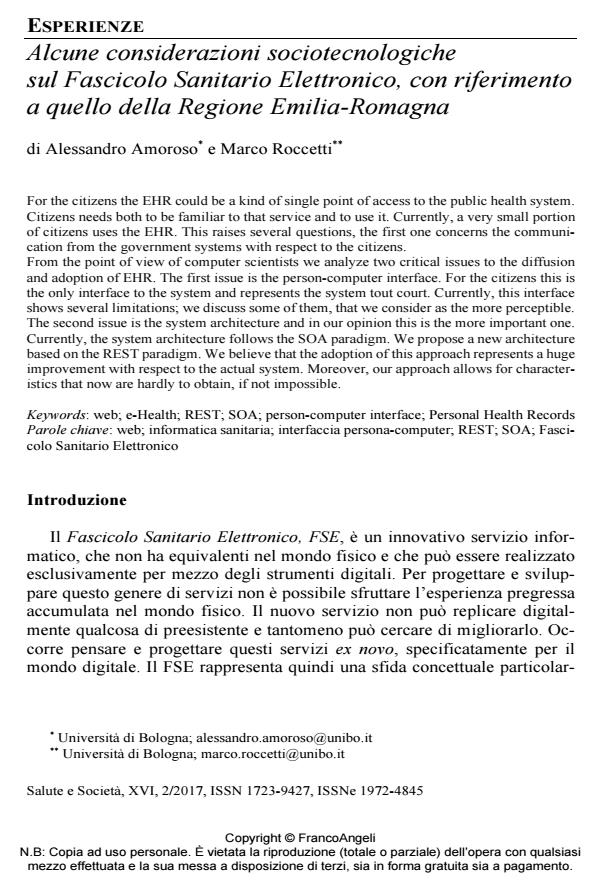Alcune considerazioni sociotecnologiche sul Fascicolo Sanitario Elettronico, con riferimento a quello della Regione Emilia-Romagna
Journal title SALUTE E SOCIETÀ
Author/s Alessandro Amoroso, Marco Roccetti
Publishing Year 2017 Issue 2017/2 Language Italian
Pages 28 P. 97-124 File size 664 KB
DOI 10.3280/SES2017-002008
DOI is like a bar code for intellectual property: to have more infomation
click here
Below, you can see the article first page
If you want to buy this article in PDF format, you can do it, following the instructions to buy download credits

FrancoAngeli is member of Publishers International Linking Association, Inc (PILA), a not-for-profit association which run the CrossRef service enabling links to and from online scholarly content.
For the citizens the EHR could be a kind of single point of access to the public health system. Citizens needs both to be familiar to that service and to use it. Currently, a very small portion of citizens uses the EHR. This raises several questions, the first one concerns the communication from the government systems with respect to the citizens. From the point of view of computer scientists we analyze two critical issues to the diffusion and adoption of EHR. The first issue is the person-computer interface. For the citizens this is the only interface to the system and represents the system tout court. Currently, this interface shows several limitations; we discuss some of them, that we consider as the more perceptible. The second issue is the system architecture and in our opinion this is the more important one. Currently, the system architecture follows the SOA paradigm. We propose a new architecture based on the REST paradigm. We believe that the adoption of this approach represents a huge improvement with respect to the actual system. Moreover, our approach allows for characteristics that now are hardly to obtain, if not impossible.
Keywords: Web; e-Health; REST; SOA; person-computer interface; Personal Health Records
- Agenzia per l’Italia Digitale. (2015). Carta Nazionale dei Servizi. --Disponibile al sito: http://www.agid.gov.it/agenda-digitale/infrastrutture-architetture/carta-nazionale-servizi
- Agenzia per l’Italia Digitale. (2016). spid. --Disponibile al sito: http://www.spid.gov.it
- Bender D. & Sartipi K. (2013). HL7 FHIR: An Agile and RESTful approach to healthcare information exchange. 26th IEEE International Symposium on Computer-Based Medical Systems, CBMS 2013: 326-31. Piscatanaway: IEEE.
- British Government (2012). Digital Efficiency Report. --Disponibile al sito: https://www.gov.uk/government/collections/ict-strategy-resources (ultimo accesso 22 aprile 2016)
- Colouris G., Dollimore J., Kindberg T. & Blair G. (2012). Distributed Systems Concepts and Design. Boston: Pearson.
- Comitato Scientifico di CUP 2000 SpA (2015). Rapporto tra innovazione e bisogno: l'utilizzo del FSE in Emilia Romagna come risposta ai bisogni effettivi di salute dei cittadini. --Disponibile al sito: http://www.sanita24.ilsole24ore.com/pdf2010 /Editrice/ILSOLE24ORE/QUOTIDIANO_SANITA/Online/_Oggetti_Correlati/Documenti/2015/10/28/Fseemilia.pdf?uuid=ACKI7BOB
- Cup 2000 e-care. (2016). Primo Accesso. --Disponibile al sito: http://support.fascicolo-sanitario.it/node/15 (ultimo accesso 27 gennaio 2016)
- DuVander A. (2010). New Job Requirement: Experience Building RESTful APIs. --Disponibile al sito: http://www.programmableweb.com/news/new-job-requi rement-experience-building-restful-apis/2010/06/09 (ultimo accesso 28 maggio 2016)
- F.Me. (2016, Maggio 4). E-health, in Italia vale 1,34 miliardi: in pole la cartella elettronica. --Disponibile al sito: http://www.corrierecomunicazioni.it/pa-digitale/41229_e-health-in-italia-vale-134-miliardi-in-pole-la-cartella-elettronica.htm (ultimo accesso 4 maggio 2016)
- Fielding R.T. (2000). Architectural Styles and the Design of Network-based Software Architectures – Doctoral dissertation. Irvine: Universtity of California.
- Government Digital Service, Cabinet Office – UK. (2014). Digital By Default. --Disponibile al sito: http://www.digitalbydefaultnews.co.uk
- Infocert. (2015). Business Key. --Disponibile al sito: https://www.firma.info cert.it/installazione/bk.php
- Lane Fox M. (2014). When the UK goes 'digital by default', who will be left behind? --Disponibile al sito: https://www.theguardian.com/technology/2014/jun/23/ when-the-uk-goes-digital-by-default-who-will-be-left-behind
- Ministero della Salute (2010). Il Fascicolo Sanitario Elettronico Linee guida nazionali. --Disponibile al sito: http://www.salute.gov.it/imgs/C_17_pubblicazio ni_1465_allegato.pdf
- Ministero per l’Innovazione e le Tecnologie. (2005). Direttiva del 4 gennaio 2005 - Linee guida in materia di digitalizzazione dell’amministrazione. --Disponibile al sito: http://www.agid.gov.it/sites/default/files/circolari/direttiva-digitalizzazio ne-04-01-05.pdf
- O’Reilly T. (2003). REST vs. SOAP at Amazon. --Disponibile al sito: http://archive.oreilly.com/lpt/wlg/3005 (ultimo accesso 6 aprile 2016).
- Osservatorio Innovazione Digitale in Sanità – Politecnico di Milano. (2015). Innovazione digitale in sanità: dai patti ai fatti. --Disponibile al sito: http://www.osservatori.net/dati-e-pubblicazioni/dettaglio/journal_content/56_INSTANCE_VP56/10402/1744417
- Osservatorio Innovazione Digitlae in Sanità. (2015). Infografica Innovazione digitale in sanità. --Disponibile al sito: http://www.osservatori.net/dati-e-pubblicazioni/dettaglio/journal_content/56_INSTANCE_VP56/10402/1744417 (ultimo accesso 10 settembre 2015)
- PiTER, Regione Emilia-Romagna. (2015). Benchmarking della società dell’informazione in Emilia-Romagna. --Disponibile al sito: http://digitale.regione.emilia-romagna.it/dati/pdf/pubblicazioni/benchmarking-della-societa-dell2019informazione-in-emilia-romagna/benchmarking-della-societa-dell2019informazione-in-emilia-romagna-2015/at_download/file/rapporto%20bench%202015%20ok.pdf
- Regione Emilia-Romagna. (2016). Il portale della Regione Emilia-Romagna. --Disponibile al sito: http://www.regione.emilia-romagna.it (ultimo accesso 27 gennaio 2016)
- Rodriguez A. (2008). RESTful Web services: The basics. IBM.
- Sundvall E., Nyström M., Karlsson D., Eneling M., Chen R., & Örman H. (2013). Applying representational state transfer (REST) architecture to archetype-based electronic health record systems. BMC Medical Informatic and Decision Making, 13(1). DOI: 10.1186/1472-6947-13-5
- Tang P.C., Ash J.S., Bates D.W., Overhage J.M., & Sands D.Z. (2006). Personal Health Records: Definitions, Benefits, and Strategies for Overcoming Barriers to Adoption. Journal of the American Medical Informatics Association, 13(2): 121-126.
- Van den Bosch A., Bogers T., & de Kunder M. (2016). Estimating search engine index size variability: a 9-year longitudinal study. Scientometrics, 107(2): 839-856.
- Vitali F., Amoroso A., & Roccetti M. (2014). RESTful Services for an Innovative E-Health Infrastructure: A Real Case Study. 16th IEEE International Conference on E-health Networking, Application & Services (IEEE HEALTHCOM). Piscatanaway: IEEE Communications Society.
- W3C (2007). SOAP Version 1.2 Part 1: Messaging Framework (Second Edition). --Disponibile al sito: http://www.w3.org/TR/soap12/
- Wikipedia (2016). SQL Injection. --Disponibile al sito: https://en.wikipedia.org/ wiki/SQL_injection
Alessandro Amoroso, Marco Roccetti, Alcune considerazioni sociotecnologiche sul Fascicolo Sanitario Elettronico, con riferimento a quello della Regione Emilia-Romagna in "SALUTE E SOCIETÀ" 2/2017, pp 97-124, DOI: 10.3280/SES2017-002008